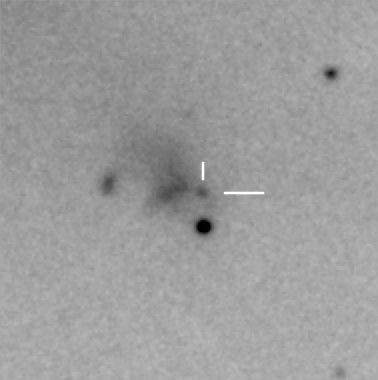[/caption]
Almost immediately after it was discovered last November by 14-year-old Caroline Moore of the Puckett Observatory Supernova Search Team, professional astronomers knew supernova SN2008ha was a strange one. The spectra of the blast showed no signs of hydrogen, which meant it must be a Type Ia supernova caused by the explosion of a white dwarf accreting matter in a binary star system. But if so, why was it some 50 times fainter than other supernova of its type?
Now in a controversial new paper in the journal Nature, astronomers from Queen’s University Belfast have proposed a new explanation of this supernova. The researchers, led by Dr. Stefano Valenti, suggest that even though the explosion contained no hydrogen, SN2008ha could be a Type II supernova, the kind caused by the core collapse of a massive star.
Valenti and his colleagues argue that, despite the lack of hydrogen, the spectrum of SN2008ha more closely resembles Type II supernovae. They cite the lack of emission lines from ionized silicon as as evidence of why SN2008ha is not a Type Ia. And they cite other supernovae that exhibited similar characteristics, which he says might be less extreme examples of hydrogen-deficient Type II supernovae.
“SN2008ha is the most extreme example of a group of supernovae that show similar properties”, said Dr. Valenti. Up until now the community had thought that they were from the explosion of white dwarfs, which we call type Ia supernovae. But we think SN2008ha doesn’t quite fit this picture and appears physically related to massive stars”.
But if SN2008ha is a Type II supernova, where did the hydrogen go? The answer might be mass loss. Some stars are so massive and luminous that they lose their outer hydrogen layers in strong outflowing stellar winds. And because they’re so massive, their cores collapse into a black hole without transfering energy to the outer layers of the star, which may explain the low luminosity of the explosion.
“The implications are quite important. If this is a massive star explosion, then it is the first one that might fit the theoretical models of massive stars that lose their outer layers through their huge luminosity pressure and then, perhaps, collapse to black holes with a whimper”, said Dr. Valenti.
Professor Stephen Smartt from Queen’s added “This is still quite controversial, we have put this idea forward and it certainly needs to be taken seriously.
Dr. Valenti’s team is keen to use new deep, time resolved surveys of the Universe to find more of these and test their ideas. One such experiment is the first of the Pan-STARRS telescopes that has started surveying the sky in the last month.
Source: Queen’s University Belfast
Original Paper: Nature


I was at first curious as to how the researchers accounted for internal galactic absorption in this particular supernova. Upon reading a copy of the preprint: http://arxiv.org/abs/0901.2074v2 . I see they found very little intrinsic absorption in this galaxy. The paper also brings up implications for nearby long GRBs and has several other peculiar SNe highlighted. Unusually dim luminosity coupled with missing hydrogen lines rightly needs to be adequately explained.
Could this affect the calculation of Dark Energy using supernovae luminosities?
A second paper by an independent team of researchers is available here: http://arxiv.org/abs/0902.2794v2 . @jimmNJ, I think that Type Ia supernovae were used to infer the existence of Dark Energy, so these underluminous Type II supernovae should not alter the evidence for DE.
As if this type of peculiar supernova weren’t enough, researchers just posted an eprint entitled “A new type of stellar explosion” discussing an underluminous Type Ib supernova in the galaxy NGC 1032 back in 2005. The paper can be found here: http://arxiv.org/abs/0906.2003 . Some similarities between it (SN 2005E) and SN 2008ha are mentioned in the paper.